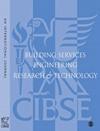英国某超市三种建设方式的全寿命碳比较分析
IF 1.8
4区 工程技术
Q3 CONSTRUCTION & BUILDING TECHNOLOGY
Building Services Engineering Research & Technology
Pub Date : 2023-03-06
DOI:10.1177/01436244231161070
引用次数: 1
摘要
建筑环境一直是全球碳排放的重要因素。因此,它在减少未来气候变化的努力中发挥着至关重要的作用。虽然建筑设计可能会决定建筑运营阶段制冷、供暖和照明的未来能源使用,但本研究旨在观察建筑设计对运营和终身碳排放的影响。过去的研究主要集中在建筑的运行碳或内含碳上。本研究对一家典型的英国超市进行了从摇篮到坟墓的评估,探讨了内含碳和运营碳之间的关系。此外,它还考察了同一设计的三种获批施工方法之间的变量对碳的整个寿命的影响。这些方法包括钢结构框架和覆面板外墙、钢框架和多孔墙、预制混凝土和胶合木框架以及预制混凝土墙。这项研究的结果将有助于缓解超市建筑施工对环境的影响,同时为未来评估超市建筑的全寿命碳提供一个框架。实际应用本文采用生命周期评估方法,通过观察整个生命周期的碳,考察了最大限度地减少内含碳和操作碳的潜力。强调各阶段温室气体排放促成因素对彼此的影响。此外,本案例研究中超市建筑类型的推荐方法也适用于其他类型的建筑。这些发现还可以加强碳排放研究,并指导超市建筑向低碳密集型发展。此外,与行业合作开展这项研究有助于将这些发现作为工程师和设计师减少建筑行业有害环境影响的实践和理论指南。本文章由计算机程序翻译,如有差异,请以英文原文为准。
Comparative analysis of the whole life carbon of three construction methods of a UK-based supermarket
The built environment has been a significant contributor to global carbon emissions. It, therefore, has a vital role to play in the reduction efforts of future climate change. While the design of buildings may determine future energy use for cooling, heating, and lighting during the operational stage of the building, this study aims to observe the effect of the building design on the operational as well as the whole-life carbon emissions. Past studies have focused on either the operational carbon or the embodied carbon of a building. Using a cradle-to-grave assessment of a typical UK supermarket, this study explores the relationship between embodied carbon and operational carbon. Additionally, it examines the effects of the variables between three approved construction methods of the same design on the whole life of carbon. These methods are a steel structural frame and cladding panel external wall, steel frame and poroton walls, precast concrete and glulam frame and precast concrete walls. The findings of this research will contribute to mitigation strategies for the environmental impacts of supermarket building construction whilst providing a framework for future assessment of the whole-life carbon of supermarket buildings.
Practical Application
Employing the life cycle assessment methodology, this paper examines the potential of minimising both embodied and operational carbon by observing the whole life carbon. Highlighting the influence of the GHG emission contributing factors in each stage on each other. Additionally, the recommended methodology for the supermarket building types of this case study, could be adapted for other types of buildings. The findings could also augment carbon emission research and guide the development of supermarket buildings to low carbon intensive. Furthermore, collaboration with the industry in carrying out this research aids in adopting the findings as practical and theoretical guides for engineers and designers in reducing the building sector’s harmful environmental impact.
求助全文
通过发布文献求助,成功后即可免费获取论文全文。
去求助
来源期刊

Building Services Engineering Research & Technology
工程技术-结构与建筑技术
CiteScore
4.30
自引率
5.90%
发文量
38
审稿时长
>12 weeks
期刊介绍:
Building Services Engineering Research & Technology is one of the foremost, international peer reviewed journals that publishes the highest quality original research relevant to today’s Built Environment. Published in conjunction with CIBSE, this impressive journal reports on the latest research providing you with an invaluable guide to recent developments in the field.
 求助内容:
求助内容: 应助结果提醒方式:
应助结果提醒方式:


